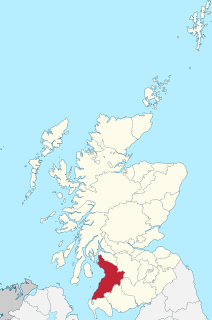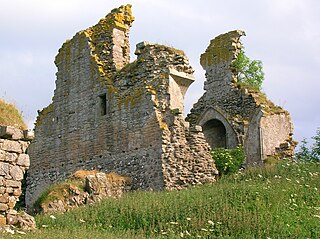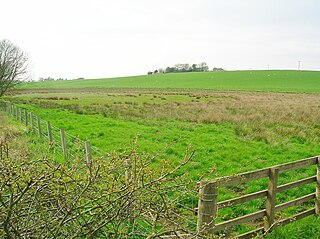
Ayrshire is a historic county and registration county in south-west Scotland, located on the shores of the Firth of Clyde. Its principal towns include Ayr, Kilmarnock and Irvine and it borders the counties of Renfrewshire and Lanarkshire to the north-east, Dumfriesshire to the south-east, and Kirkcudbrightshire and Wigtownshire to the south. Like many other counties of Scotland it currently has no administrative function, instead being sub-divided into the council areas of North Ayrshire, South Ayrshire and East Ayrshire. It has a population of approximately 366,800.

Auchinleck House is an 18th-century mansion in Scotland. It is situated near the town of Auchinleck near Cumnock and Ayr in East Ayrshire. The Auchinleck Estate has been inhabited since the 13th century, and the remains of Auchinleck Castle and Auchinleck Old House stand in the estate. The house is protected as a category A listed building, while the two ruined dwellings are scheduled monuments.

Lord Ochiltree of Lord Stuart of Ochiltree was a title in the Peerage of Scotland. In 1542 Andrew Stewart, 2nd Lord Avondale exchanged the lordship of Avondale with Sir James Hamilton for the lordship of Ochiltrie and by Act of Parliament was ordained to be styled Lord Stuart of Ochiltrie. His great-grandson, the third Lord Stuart of Ochiltrie, resigned the feudal barony of Ochiltree and the peerage to his cousin, James Stewart, with the consent of the Crown in 1615. In 1619 he was instead elevated to the Peerage of Ireland as Baron Castle Stewart; see the Earl Castle Stewart for further history of this branch of the family).

Ochiltree is a conservation village in East Ayrshire, Scotland, near Auchinleck and Cumnock. It is one of the oldest villages in East Ayrshire, with archaeological remains indicating Stone Age and Bronze Age settlers. A cinerary urn was found in 1955 during excavation for a new housing estate.

Clan Colville is a Lowland Scottish clan.

Busbie Castle was situated in what is now known as Knockentiber, a village in East Ayrshire, Parish of Kilmaurs, Scotland. Knockentiber is 2 miles (3.2 km) WNW of Kilmarnock and 1/2 mile NE of Crosshouse. The castle overlooked the Carmel Glen and its Burn, which runs into the River Irvine, a mile or so to the south, after passing through the old Busbie Mill.
Thomas Cochrane, 8th Earl of Dundonald was a Scottish nobleman, army officer and politician. He was Member of Parliament for Renfrewshire, 1722–1727. He served as Commissioner of the Excise for Scotland from 1730 until 1764. He acceded to the title of Earl of Dundonald in 1758 on the death of his cousin, William Cochrane, 7th Earl of Dundonald.

Craigie Castle, in the old Barony of Craigie, is a ruined fortification situated about 4 miles (6.4 km) southeast of Kilmarnock and 1 mile (1.6 km) southeast of Craigie village, in the Civil Parish of Craigie, South Ayrshire, Scotland. The castle is recognised as one of the earliest buildings in the county. It lies about 1.25 miles (2 km) west-south-west of Craigie church. Craigie Castle is protected as a scheduled monument.

The Castle and Barony of Robertland is located near Stewarton, off the B769 road, in the old district of Cunninghame, Parish of Stewarton, and now part of East Ayrshire, Scotland.
William Cochrane, 1st Earl of Dundonald supported the Royalist cause during the Wars of the Three Kingdoms.

The Loch of Trabboch or Dalrympleston Loch (NS440211) was situated in a low-lying area below the old Castle of Trabboch, once held by the Boyd family in the Parish of Stair, East Ayrshire, Scotland.
Trabboch Castle is a ruined L-plan tower house in the old Barony of Trabboch, Parish of Stair, East Ayrshire, Scotland.
Andrew Stewart, 2nd Lord Avondale or Andrew Stuart, 1st Lord Ochiltree, was a Scottish peer.
Andrew Stewart, 2nd Lord Ochiltree fought for the Scottish Reformation. His daughter married John Knox and he played a part in the defeat of Mary, Queen of Scots at the battle of Langside.
Sir James Colville of Easter Wemyss was a Scottish administrator, lord of session and diplomat.

Peden's Cave is at least partly artificial and is set into a craggy outcrop of red sandstone rocks overlooking the River Lugar just below the farm of Auchinbay in East Ayrshire, Scotland, close to the town of Ochiltree. Traditionally it is said that this cave was used as a hiding place for Covenanters, including the famous Covenanter minister Alexander Peden in the 17th century, mainly during the so-called 'Killing Times' of the 1680s.

Wallace's Cave in the Lugar Gorge at Auchinleck in the Parish of Auchinleck is an 18th-century grotto contemporary with Dr Johnson's Summerhouse, also located on the Auchinleck Estate. It shows superior workmanship in its construction, possibly being the enlargement of a pre-existing cave. The cave or grotto lies downstream of the confluence of the Dippol Burn with the River Lugar and is reached via a once well formed path, however access is now hazardous due to the condition of the cliff edge path and the vertical drop into the River Lugar.

The Bickering bush (NS41863635) thorn grew near Caprington on the lands of Monksholm or Maxholm, Riccarton, East Ayrshire, Scotland. The old farm house at Maxholm sat in hollow on the old Caprington Castle estate and to the north and west its fields bordered the River Irvine. The thorn was located, as recorded on the OS map, near to the confluence of the Kilmarnock Water and the River Irvine, downstream of the Simon's Burn's confluence on the south bank of the river.
Margaret Stewart, Mistress of Ochiltree was a courtier in the household of Anne of Denmark in Scotland and looked after her children Prince Henry, Princess Elizabeth, and Charles I of England
Thomas Kennedy of Bargany was a Scottish courtier and landowner.













